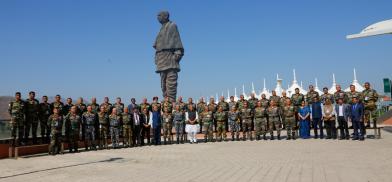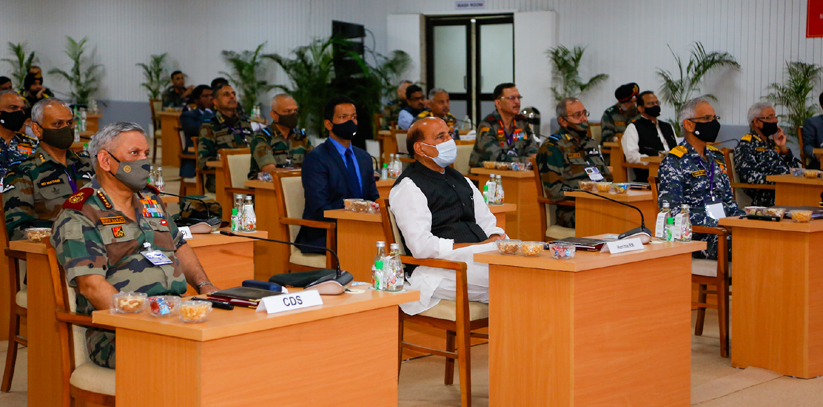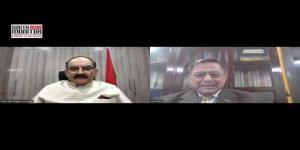A military commanders’ meet that was packed with significance
The idea to hold the Combined Commanders’ Conference (CCC) at Kevadia, Gujarat is packed with a significance which strikes those aware of India’s post-Independence history, which was swept under the carpet

The idea to hold the Combined Commanders’ Conference (CCC) at Kevadia, Gujarat is packed with a significance which strikes those aware of India’s post-Independence history, which was swept under the carpet. The significance stands out vividly in the group photograph of the participants with the first deputy prime minister of India, Sardar Vallabhbhai Patel’s statue – the Statue of Unity - looming large behind them.
In the CCC the country’s combined top-level military leadership reviews the security situation and defence preparedness of the Armed Forces and deliberates on relevant organisational issues for evolving a joint military vision for the future.
Defence Minister Rajnath Singh was joined by the three services chiefs, the military commanders alongwith secretary-level officers from the Defence Ministry from the second day of the conference. The valedictory session on March 7, the third and final day, was chaired by Prime Minister Narendra Modi with National Security Advisor Ajit Doval also attending.
For the first time in a major change from the past, the scope of the CCC was expanded to include about 30 junior-commissioned and non-commissioned officers from the three services. Key events included a series of discussions and deliberations on a range of issues pertaining to the armed forces and its role in nation-building, with the participation of the senior-most political and bureaucratic hierarchy, for the first time, multi-layered participation of military personnel.
The Defence Organisation since including the appointment of the first-ever Chief of Defence Staff and setting up of the Department of Military Affairs (DMA), and several important and multifarious issues affecting modernisation and transformation of the armed forces are currently under active consideration/implementation.

Held in South Block, which houses the Prime Minister's Office, Ministry of Defence and Ministry of External Affair, for decades since Independence, it is only since the Bharatiya Janata Party (BJP) government took over that its venue has been changed. In 2015, the CCC was held aboard INS Vikramaditya, India’s sole aircraft carrier, in 2017 at the Indian Military Academy, Dehradun, Uttarakhand, and in 2018 at Jodhpur, in Rajasthan.
Holding the CCC in Kevadia is no doubt considered as yet another way of paying a long overdue tribute to Sardar Patel, who not only very effectively and swiftly integrated India’s 562 kingdoms referred to as princely states, but also had many more sound and important suggestions for India’s security, particularly on China and Pakistan, which the first prime minister Jawaharlal Nehru prevented from being accepted.
India’s Armed Forces are still paying dearly for some of Nehru’s policies/decisions on both China and Pakistan. Seen in retrospect after Sardar Patel’s death, it became obvious how shabbily Nehru treated him and his family. Nehru also became a major impediment to India’s crucial security vis a vis China and Pakistan. India’s post-Independence history would certainly have been much different had Sardar Patel has been given his due and if he had lived longer.
Another first for this CCC was that following the government’s directive, personnel below officer rank (PBOR) was made to attend this event. This move indeed surprised many serving and retired personnel. While the serving officers cannot voice their opinion publicly, many retired officers did, but on the condition of not being named. This is because they do not want to ruffle any feathers of the political leadership and unnecessarily annoy anyone and get targeted.
While holding the CCC in different locations and particularly military training academies or places of national pride is quite acceptable to serving officers and veterans, on the aspect of including PBOR, some questions come up. First of them is that many matters related to operations, international relations, the administration needs to be discussed maintaining the security of information and the principle of need to know. Operations in recent years like the surgical strikes and the Balakot bombing - conducted by India in the early morning hours of February 26, 2019, when Indian warplanes crossed the de facto border and dropped bombs in the vicinity of the town of Balakot in Khyber Pakhtunkhwa province in Pakistan - are examples of major successes owing to very tight security based on the unavoidable need to know basis.
In a forum like the CCC, even if the PBOR are only attending the opening and closing sessions there can be mention of certain issues, which are better not discussed openly between PBOR. The officer-soldier relationship/bond in the Indian Armed Forces are good to say the least and far better than a lot of armed forces of totalitarian/dictatorship countries or like China where the Chinese Communist Party (CCP) deceives its own people about its soldiers. What matters most is that the officer-soldier bond referred to in the Indian context is strong and anyone dying for the nation is given great tributes and his family looked after. The Indian Armed Forces’ command structure in which there is distance maintained between officers and PBOR has been well accepted. It has worked well and is time-tested, including for over seventy years for independent India, and should be left unaltered.
And Indian Armed Forces have maintained a system based on Sainik Sammelans (senior commanders/commanding officers addressing troops and discussing/solving their problems), regimental reunions, and religious festivals during which officers and PBOR mix. While during religious festivals all ranks of the unit irrespective of their religion, celebrate the festival together, an example which many in this country should emulate. During regimental day/battle-honour day functions officers and troops drink and dine together, recall wars/battles and even be jocular, but between limits. All these have proved to help develop regimental spirit and camaraderie which are invaluable during war.
Lastly, as pointed out by some veterans, ensuring the presence of PBOR on occasions presided upon by the Prime Minister can be used by the opposition to the drumbeat that it is a subtle means of enhancing the vote-bank and politicising the armed forces.
Since taking charge in May 2014, Modi initiated the spirit of praising the sacrifices of armed forces personnel and of inculcating national pride. India’s National War Memorial finally got built only after the BJP took over. Renaming of the iconic Teen Murti traffic roundabout as Teen Murti-Haifa Chowk in the presence of Israel’s Prime Minister Benjamin Netanyahu on January 14, 2018, was good diplomacy and another major compliment to the Indian Army for its valour and sacrifices while liberating Haifa, a city in Israel, from heavily armed German and Turkish troops during World War-I. Indian soldiers are lauded for this battle in Israeli textbooks.
Changes in time-tested traditions and customs of India’s Armed Forces only because they were instituted by the British and merely for the sake of change should be avoided. Because many of them have helped Indian Armed Forces to remain to date as one of the best in the world. Those that did not suit us were jettisoned or changed after Independence. Any more that needs to be changed or new ones introduced should only be done after enough civil-military deliberation.
(The author is a former spokesperson, Indian Army and Ministry of Defence. The views are personal. He can be contacted at wordsword02@gmail.com)










Post a Comment